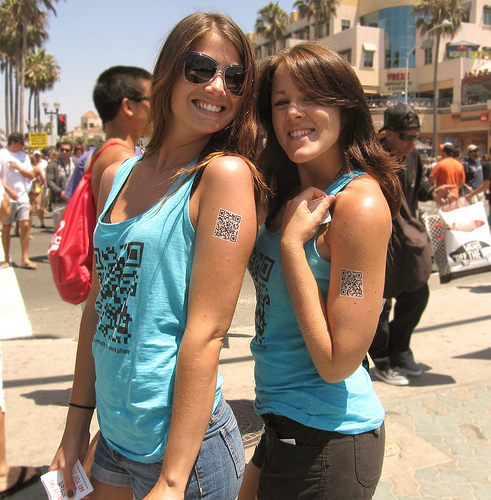Beach Bodies and QR Codes at the US Open of Surfing
Oral Cancer Foundation Uses QR Codes to Reach Target Audience at the US Open of Surfing

How does a small non-profit, with limited financial and human resources, fulfill a mission which includes the daunting task of informing the American public about these changing risk factors for a deadly disease? In the case of the US Open of Surfing, the Oral Cancer Foundation became the early adopters of an emerging technology, QR codes, and employed that with what have often been called guerilla-marketing techniques.
QR (for Quick Response) codes are based on a two-dimensional bar code technology that was developed in Japan and is now starting to be used by US marketers, from designer Ralph Lauren, cosmetic giant Clinique, to Michelin tires. QR codes are square-shaped, seemingly random patterns that can appear in a variety of locations including magazine or newspaper ads, pamphlets, posters, packaging and even billboards. When an iPhone, Droid, or other smart phone scans a QR code with its camera, the user is immediately taken to whatever content, perhaps a website, a video, etc. that has been programmed by the QR code owner.
This past weekend the US Open of Surfing, sponsored by action sports industry giant Hurley International was held in "Surf City" attracting over 500,000 visitors during the three-day event. The crowd of sun and surf lovers was dominated by teens and 20 somethings that besides their love of the beach also shared their connectivity to social networking environments, often with multi-functional smart phones. For the Oral Cancer Foundation who needs to spread important medical information about risk factors for the disease they represent, to a group of individuals that are increasingly becoming part of the "at risk" population, this was a mix of ingredients too rich to miss.
At the US Open of Surfing, teams of young women hired by the Oral Cancer Foundation for three days handed out creatively worded stickers, T-shirts, and even temporary tattoos, all bearing a special QR code to the crowd. When beach-goers scanned the QR code with their smart phones, they were taken to a specially designed web page informing them that oral cancer can be caused by the sexually-transmitted human papilloma virus, the risk factors for it, and what they could do to avoid the cancer it can cause.
Oral cancer itself is off the radar of most Americans, let alone the fact that the fastest growing segment of the oral cancer population are young, non-smoking, and  predominantly white. Historically this has not been the case. Individuals with several decades of tobacco use, in their fifth to seventh decade of life, two-to-one black over white, and 3-1 males over females have been the relatively stable high-risk population for decades. But today, a very common virus is changing all that.
predominantly white. Historically this has not been the case. Individuals with several decades of tobacco use, in their fifth to seventh decade of life, two-to-one black over white, and 3-1 males over females have been the relatively stable high-risk population for decades. But today, a very common virus is changing all that.
Human Papilloma Virus (HPV) has around 130 versions, 9 are known causes of cancer, and another 6 are often found in association with those. The most commonly known cancer associated with HPV is cervical cancer. But to most Americans the other cancers that HPV initiates are not widely known. HPV16 has been firmly linked to the development of oral cancers, particularly of the posterior part of the mouth, and the rate at which it is spreading is alarming. The transfer mechanism of the virus is through direct contact, and in oral cancers the most common means is oral sex or even passionate (French) kissing.
Megan Cannon is a 24-year-old that strongly relates to those at the surf event. She is also the Oral Cancer Foundation's Director of Social Media who oversaw the Foundation's efforts at the Huntington Beach event. "People were really blown away by the QR code technology. To point your phone at an unusual-looking pattern and suddenly be taken to an interesting website makes for a pretty memorable experience," she said. Ms. Cannon added, "More important, it allowed OCF to communicate our very provocative, and potentially life saving message — that the cause for oral cancer can be sexually-transmitted — in a very powerful way." The Oral Cancer Foundation is believed to be the first non-profit organization in the country to use QR codes in its outreach for public good.
Ms. Cannon explained that she had come across the technology when exploring new social networking possibilities and seeing a highly successful QR campaign by Calvin Klein used on billboards in major metropolitan areas. The images on the often racy CK billboards had been replaced by this unusual, scanable QR code, which took mobile phone users to rich content on the web. "Working in an environment like OCF, that encourages out of the box thinking and often obtuse approaches to accomplishing our mission, allowed me to present a message with a distinctly sexual content in a provocative but appropriate manner. Calvin Klein's high profile example, when adapted to the 500,000 young people at the US Open of Surfing, with teams of young people spreading the OCF's public service QR code throughout a crowd that were smart phone savvy, was both cost effective and resulted in a highly successful public awareness effort."
 Finding innovative ways to get its message across is nothing new for the Oral Cancer Foundation. It launched the world's first in depth informational website dedicated to the disease in 1999. The website now receives between 18 million and 25 million hits each and every month, and has for years been the number one Google find for the disease. At a time when few people knew about the now common RSS (Really Simple Syndication) feeds to allow people to automatically subscribe to and be notified of new web content, the Oral Cancer Foundation established the free Oral Cancer Newsfeed, which daily is updated with articles from research to human interest stories about the disease. Today thousands of patients, family members, clinicians, students, researchers and other individuals are devoted subscribers.
Finding innovative ways to get its message across is nothing new for the Oral Cancer Foundation. It launched the world's first in depth informational website dedicated to the disease in 1999. The website now receives between 18 million and 25 million hits each and every month, and has for years been the number one Google find for the disease. At a time when few people knew about the now common RSS (Really Simple Syndication) feeds to allow people to automatically subscribe to and be notified of new web content, the Oral Cancer Foundation established the free Oral Cancer Newsfeed, which daily is updated with articles from research to human interest stories about the disease. Today thousands of patients, family members, clinicians, students, researchers and other individuals are devoted subscribers.
Patient support, which had historically been managed through monthly face to face meetings at treatment facilities, was a system that when OCF's Founder Brian Hill came out of treatment, he found woefully inadequate. "I needed to talk to people almost daily, not once a month. I was still in pain, still dealing with treatment related complications, and there was the emotional upheaval that cancer brings with it," he states. OCF's solution was a web based support system, anonymous and free, where at any hour of the day interactions between patients could take place. Moderated carefully for content, it now has a population of registered users approaching 7,000, and even with monthly pruning of old postings, has approximately 100,000 postings on it. It's Sunday AM and you need to talk with someone regarding a problem as a patient or caregiver? There are posters on the forum boards, mostly volunteer survivors who have been down the path before you from around the world online. People from Hong Kong, Australia, the UK, to the US, all helping each other get through what is the most difficult of times; made possible by the innovative use of technology.
Accolades for OCF's innovations have been many. In 2009, the Oral Cancer Foundation was praised by social media guru Mashable.com for effectively using Internet-based social media for the public good. The Foundation was also recently named the best small cancer non-profit in the US, receiving the Cancer Fighter Award from Great Non-Profits, the leading provider of user-generated ratings and reviews of non-profit organizations. Founder Brian Hill has stated that the pursuit of technology to accomplish the mission was "design driven by necessity. Even with one person dying every hour of the day from oral cancer in the US, we just do not get the funding and attention this disease merits. Without that financial support, we have to be creative to make progress against this disease."
Curtis Kabat, of Kabat Entertainment Group, a long time OCF supporter and donor to the foundation commented, "In the case of OCF, small does not equal an inability to have significant impact. On the contrary, it showcases a superb model for exceptional returns on donor gifts. In today's economic environment this is the style of charity organization that deserves more notice." Susan Lauria, who lost her brother to the disease, and subsequently became a long-term donor and volunteer to the Foundation remarked, "This is an organization that produces tangible results for donors. I am not only amazed at how much they can do with so little, but pleased to see that my donations are used in both prudent and meaningful ways."
Limited budgets place a premium on finding the perfect alignment of target audience, message, medium and setting. OCF understands this well. Dr. Ross Kerr, an oral medicine specialist from NYU who has watched and worked with OCF since their beginning, stated, "What this organization lacks in infrastructure it makes up for in the development of strategic alliances. What it lacks in raw dollars to get their message out, it makes up for in creative and innovative approaches; capitalizing on low cost but highly effective technologies, often convincing celebrity spokespeople to deliver its message. What it does not lack is a true passion to serve the needs of others. I am not surprised to see their continuing adaptive character embrace the increasingly mobile nature of information dissemination that smart phones make possible."
To see the content of the OCF-QR code used at this event follow this link: http://www.oralcancer-qr.org/
